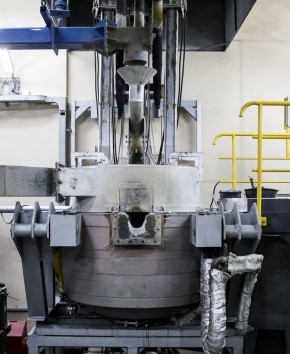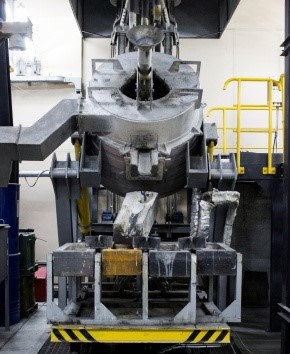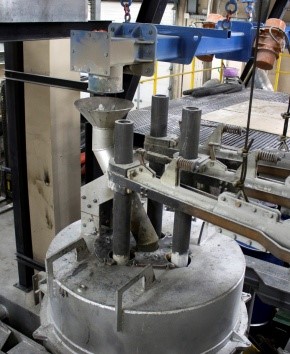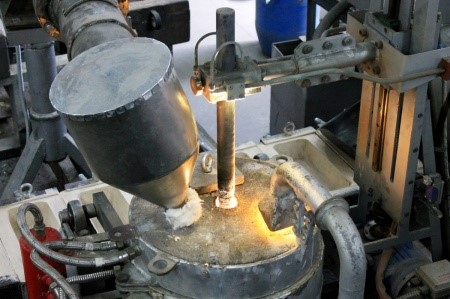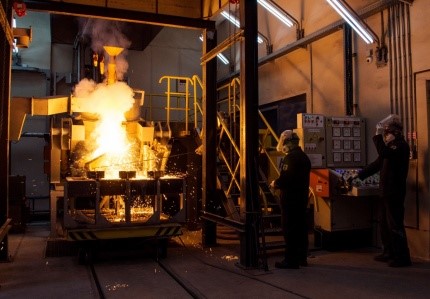Electrical Arc Furnace
Technological complex
“OUR PARTNER” demonstrates to potential partners not only technology, but also furnace equipment for its implementation. The furnaces are distinguished by simplicity and reliability of design, availability in control, durability of refractory lining due to efficient cooling systems and high-quality refractories, economical consumption of electricity, electrodes and lining materials, and most importantly, unique technical solutions of the power unit and control algorithms that ensure high stability and controllability of the arc in wide range of voltage and operating currents.
Three-electrode 450kVA furnace
The filling volume of a 450 kVA furnace is 500 kg of dry charge. The net melting time is determined solely by the nature of the feed material. The higher its specific heat of fusion, as well as the energy of endothermic reactions, the longer the melting time. For example, when melting automobile neutralizers, the melting rate is about 200 kg of charge per hour. The time of the full cycle of accumulative smelting, including all auxiliary operations (heating, loading, holding, temperature measurement, intermediate drainage, preparation of molds for the next drain, etc.), in a single-shift furnace operation is 10-12 hours with several intermediate slag drainages … The daily productivity of the charge during continuous operation of the furnace can exceed 3 tons. The furnace is equipped with a water cooling system, a continuous feed system,
Single electrode 45kVA furnace
Experimental melts during the development of technology (charge formulations and melting modes) are carried out on a small (enlarged laboratory) furnace with a filling volume of up to 50 kg of dry charge. The small size of the furnace allows, on the one hand, to save on the volume of raw materials spent on experimental smelting, and on the other, to obtain faster results, while involving only two people for such work. The small power and compactness of the furnace make it possible to use it in places where there is no high voltage (a 380 V source for 60 kW is enough), and the possibility of cooling even with running water, and the presence of a mobile exhaust gas filter, make the whole complex mobile enough to carry out experimental work directly if necessary at the customer’s enterprise.
Advantages of short arc furnaces:
· Suitability for processing raw materials in finely dispersed fraction · No contact of the graphite electrode (cathode) with the metal · Minimum electrode consumption due to the transfer of arc energy from the cathode to the melt to the anode · Reduced electrode costs up to 40% · All generated ohmic energy is absorbed by the charge · Low energy losses on the side walls when they cool · Uniform distribution of energy in the crucible · Increased service life of the furnace roof and crucible walls · Reduced energy consumption · High production efficiency and profitability · More complete recovery: there is no aeration of fines and losses in the fluidized bed, because particles are drawn into the magnetic flux and accelerated in the arc plasma |
Safety
- Does not form a crust that prevents the escape of gases, which leads to explosions and accidents on AC furnaces
- Lower noise level
- Reliable water cooling system, reinforced casing design, eliminating the possibility of side wall burn-through due to the effect of cooling the molten metal.
Services
Processing of precious raw materials
The main areas of work with materials:
- Copper and nickel
- Gold, platinum, palladium, rhodium
- Ferrovanadium
- Cobalt
- Titanium
- Ferromanganese
Experimental smelting to obtain precious metal alloys from waste raw materials: petrochemical catalysts, automobile neutralizers, spent mullite-corundum, magnesite and chromium-magnesite lining of smelting furnaces, slags, sludge, insoluble residues and other products of processing of raw materials containing precious metals.
With the most difficult and stubborn materials, we prove the benefits of DC short arc melting technology. According to laboratory data, the extraction of precious metals in the course of pyrometallurgical processing of raw materials in direct current furnaces of ETD LLC reaches 97% – 99%. Thus, raw materials, which would otherwise remain unclaimed due to the impossibility of processing, are again involved in production.
Of course, the recovery percentage always depends on the concentration of precious metals in the feedstock. However, there are key factors that allow you to achieve such high rates:
- The temperature distribution in the DC furnace melt is more even, because the current flows through the entire thickness of the melt (and is not limited only by the interelectrode space, as it happens in AC arc furnaces). This is very important for optimization in volume of such important parameters of the melt as viscous flow and density of the slag phase.
- Effective mixing of the melt. The directed movement of the plasma flow of the arc, as well as convection flows inside the melt in DC furnaces, displaces the warmer masses of the melt to the periphery, replacing the colder masses and adjusting them to the arc. This process produces the effect of intense concentric mixing that encompasses the entire volume of the melt and is key to maximizing the recovery of precious metals from the melt by the collector metal.
- Continuous loading of the charge. Unlike AC furnaces, where the charge is completely loaded into the furnace before melting begins, in DC furnaces, continuous charging can be used, in which the charge is fed into the working area as it melts. The continuous charging method prevents the appearance of dead zones and the deposition of unreacted charge on the hearth, which can occur in AC furnaces in the case of poor solubility or high melting point of individual components of the charge.
- Application of a three-electrode arrangement in the design of a DC furnace. The 450 kVA EDT furnace installed at the Krastsvetmet plant has three upper electrodes and one bottom electrode. This design, in contrast to the single-electrode design, makes it possible to more evenly distribute the arc energy transferred to the melt, reduces temperature gradients, as well as the heat load on the furnace lining. This provides not one, but as many as three melt mixing centers, one under each electrode.
- The furnace control system conducts melting in automatic mode. Arc control algorithms maintain a stable arc over a wide range of voltage and current settings. Separate know-how technologies prevent the appearance of flicker in the supply network and significantly reduce load fluctuations on the thyristors of the rectifier modules, ensuring their long service life. The feedback loop automatically regulates the feed rate of the charge depending on its melting rate, due to the specific heat of melting of the charge and the power supplied to the melt.

